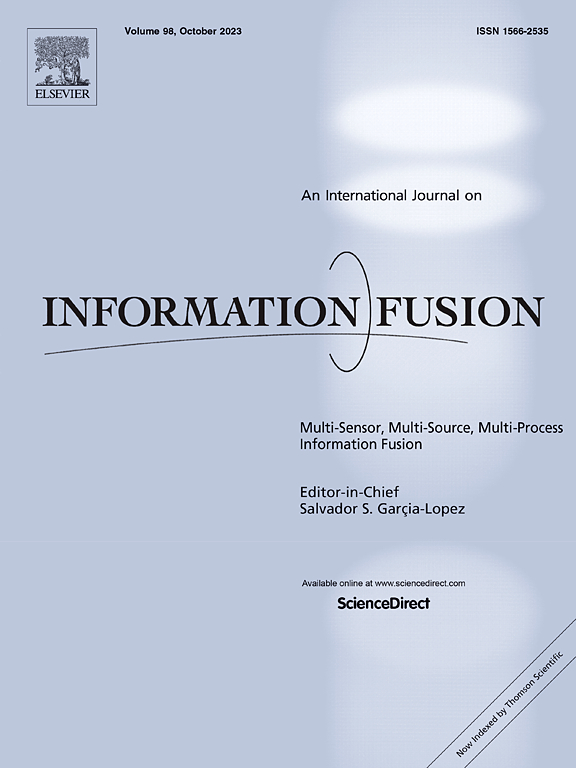CPIFuse: Toward realistic color and enhanced textures in color polarization image fusion
IF 14.7
1区 计算机科学
Q1 COMPUTER SCIENCE, ARTIFICIAL INTELLIGENCE
引用次数: 0
Abstract
Conventional image fusion aims to integrate multiple sets of source images into one with more details, representing the merging of intensity information. In contrast, polarization image fusion seeks to enhance texture of the intensity image in the corresponding spectral bands by integrating strong texture features reflected by DoLP (Degree of Linear Polarization) images, representing the combination of intensity and polarization, which are both physical properties of light. However, the 3-Dimensional information contained in DoLP is presented in a highlighted form within the 2-Dimensional image, and fusing it directly can result in spectrum discontinuities and obscuring necessary details of the fused image. Existing polarization image fusion methods do not analyze this phenomenon and fail to examine the physical information represented by DoLP images. Instead, they simply integrate this interference information in the same manner as fusing infrared images, leading to fused images that suffer from information loss and significant color discrepancies. In this paper, we propose a new color polarization image fusion strategy that takes into account the physical properties reflected in the and DoLP images, namely CPIFuse. CPIFuse designs a customized loss function to optimize parameters through a lightweight Transformer-based image fusion framework, and color polarization image fusion has been achieved with color fidelity, enhanced texture and high efficiency. These advantages can be demonstrated in the visual effects, quantitative metrics, and car detection tasks of our comparative experiments. Furthermore, a new polarization dataset is constructed by the mechanism of division of focal plane polarimeter camera, which addresses the scarcity of datasets in the field of polarization image fusion. The source code and CPIF-dataset will be available at https://github.com/roydon-luo/CPIFuse.
CPIFuse:在彩色偏振图像融合中实现逼真的色彩和增强的纹理
传统图像融合的目的是将多组源图像融合为一组具有更多细节的图像,表现为强度信息的融合。而偏振图像融合则是通过整合DoLP (Degree of Linear polarization)图像所反映的强烈纹理特征,来增强强度图像S0在对应光谱波段的纹理,代表强度与偏振的结合,这两者都是光的物理性质。然而,DoLP中包含的三维信息在二维图像中以高亮的形式呈现,直接融合会导致光谱不连续,模糊融合图像的必要细节。现有的偏振图像融合方法没有对这一现象进行分析,也没有检测到DoLP图像所代表的物理信息。相反,他们只是以与融合红外图像相同的方式整合这些干扰信息,导致融合的图像遭受信息丢失和显着的颜色差异。在本文中,我们提出了一种考虑到S0和DoLP图像所反映的物理特性的彩色偏振图像融合策略,即CPIFuse。CPIFuse通过基于轻量级transformer的图像融合框架,设计定制化损失函数进行参数优化,实现了色彩保真度高、纹理增强、效率高的彩色偏振图像融合。这些优势可以在我们比较实验的视觉效果、定量指标和汽车检测任务中得到证明。在此基础上,利用焦平面偏振相机的分割机制构建了新的偏振数据集,解决了偏振图像融合领域数据集的稀缺性问题。源代码和cpif数据集可在https://github.com/roydon-luo/CPIFuse上获得。
本文章由计算机程序翻译,如有差异,请以英文原文为准。
求助全文
约1分钟内获得全文
求助全文
来源期刊

Information Fusion
工程技术-计算机:理论方法
CiteScore
33.20
自引率
4.30%
发文量
161
审稿时长
7.9 months
期刊介绍:
Information Fusion serves as a central platform for showcasing advancements in multi-sensor, multi-source, multi-process information fusion, fostering collaboration among diverse disciplines driving its progress. It is the leading outlet for sharing research and development in this field, focusing on architectures, algorithms, and applications. Papers dealing with fundamental theoretical analyses as well as those demonstrating their application to real-world problems will be welcome.
 求助内容:
求助内容: 应助结果提醒方式:
应助结果提醒方式:


